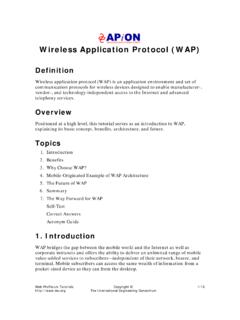Transcription of The 2015 Guide to WAN Architecture & Design - Cisco
1 Produced by: The 2015 Guide to WAN Architecture & Design By Dr. Jim Metzler, Ashton Metzler & Associates Distinguished Research Fellow and Co-Founder Webtorials Analyst Division Sponsored in part by: Table of Contents Executive Summary _____ 1 Introduction and Background _____ 2 Definition of WAN _____ 2 WAN Evolution _____ 2 WAN services _____ 2 Traditional WAN Design _____ 3 Hypothetical Company: NeedToChange _____ 4 Cisco s Response _____ 7 Key WAN Architecture and Design Considerations _____ 12 Call to Action_____ 16 2015 Guide to WAN Architecture and Design June 2015 Page 1 Executive Summary The wide area network (WAN) is a critically important topic for number of reasons.
2 Those reasons include: The latency, jitter and packet loss that is associated with the WAN often cause the performance of applications to degrade; The WAN can be a major source of security vulnerabilities; Unlike most of the components of IT, the price/performance of WAN services doesn t obey Moore s Law; The outage of a WAN link often causes one or more sites to be offline; The lead time to either install a new WAN link or to increase the capacity of an existing WAN link can be quite lengthy. A discussion of wide area networking is extremely timely because after a long period with little if any fundamental innovation, the WAN is now the focus of considerable innovation. As a result, for the first time in a decade network organizations have an opportunity to make a significant upgrade to their WAN Architecture .
3 This e-book describes a hypothetical company, referred to as NeedToChange, which has a traditional approach to WAN Design . It then presents Cisco s response to how NeedToChange should evolve its WAN. This e-book includes a summary of the key components of some of the emerging approaches to WAN Architecture and Design and concludes with a call to action that outlines a project plan that network organizations can use to evolve their WAN. 2015 Guide to WAN Architecture and Design June 2015 Page 2 Introduction and Background Definition of WAN To many network professionals the term WAN doesn t refer to the Internet but refers exclusively to enterprise WAN services such as Frame Relay, ATM or MPLS. The distinction is that enterprise WAN services were designed primarily to connect a given enterprise s branch offices and data centers while the Internet provides connectivity to a huge range of resources with myriad owners.
4 That is an arbitrary distinction that is quickly losing relevance and as a result throughout this e-book the term WAN refers to any combination of the Internet and enterprise WAN services . WAN Evolution The modern WAN got its start in 1969 with the deployment of the ARPANET which was the precursor to today s Internet. The technology used to build the Internet began to be commercialized in the early 1970s with the development of based packet switched networks. In addition to the continued evolution of the Internet, the twenty-year period that began around 1984 saw the deployment of four distinct generations of enterprise WAN technologies. For example, in the mid to late 1980s, it became common for enterprise IT organizations to deploy integrated TDM-based WANs to carry both voice and data traffic.
5 In the early 1990s, IT organizations began to deploy Frame Relay-based WANs. In the mid to late 1990s, some IT organizations replaced their Frame Relay-based WANs with WANs based on ATM (Asynchronous Transfer Mode) technology. In the 2000s, many IT organizations replaced their Frame Relay or ATM-based WANs with WANs based on MPLS. Cost savings was the primary factor that drove the adoption of each of the four generations of WAN technologies. WAN services As discussed in The 2014 State of the WAN Report, network organizations currently make relatively little use of WAN services other than MPLS and the Internet and the use they do make of those other services is decreasing somewhat rapidly. That report also identified the concerns that network organizations have with those two services .
6 Those concerns are shown in Table 1 in descending order of importance. 2015 Guide to WAN Architecture and Design June 2015 Page 3 Table 1: Concerns with WAN services Concerns with MPLS Concerns with the Internet Cost Security Uptime Uptime Latency Latency Lead time to implement new circuits Cost Security Packet loss Lead time to increase capacity on existing circuits Lead time to increase capacity on existing circuits Packet loss Lead time to implement new circuits Jitter Jitter Traditional WAN Design The traditional approach to designing a branch office WAN is to have T1 access to a service provider s MPLS network at each branch office and to have one or more higher speed links at each data center. In this Design , it is common to have all or some of a company s Internet traffic be backhauled to a data center before being handed off to the Internet.
7 One of the limitations of this Design is that since the Internet traffic transits the MPLS link this adds both cost and delay. One alternative to the traditional approach to designing a branch office WAN is to supplement the T1 access link in a branch office with direct Internet access and to also leverage technology such as Policy Based Routing (PBR). PBR allows network administrators to create routing policies to allow or deny paths based on factors such as the identity of a particular end system, the protocol or the application. One advantage of this alternative Design is that it enables network administrators to take Internet traffic off the relatively expensive MPLS link and put it on the relatively inexpensive Internet link. One disadvantage of this approach is that configuring PBR is complex, time consuming and error prone.
8 Another limitation of this approach it that it creates a static allocation of traffic to multiple links which means that it isn t possible to reallocate the traffic when the quality of one of the links degrades. 2015 Guide to WAN Architecture and Design June 2015 Page 4 Hypothetical Company: NeedToChange Cisco was given the description of a hypothetical company, referred to as NeedToChange, that has a traditional WAN and they were asked to provide their insight into how the company should evolve its WAN. Within the context of a traditional WAN there is a wide breadth of options relative to a company s WAN topology, services , applications and goals. As a result of this breadth, it wasn t feasible to cover all possible options in a reasonably sized description of NeedToChange s WAN.
9 In order to limit the size of the description of NeedToChange s WAN and yet still bring out some important WAN options, Cisco was allowed to embellish the description of NeedToChange s WAN. They could, for example, add additional data centers or key applications; vary the amount of traffic that was backhauled; prioritize the factors impacting NeedToChange s WAN or identify business drivers such as the need to support mergers and acquisitions. Below is the description of NeedToChange s WAN that Cisco received. 1. Data Centers NeedToChange has a class A data center in Salt Lake City, Utah. The site has two diversely routed T3 links into an MPLS network1 and a 100 Mbps link to the Internet. 2. Traffic Prioritization In the current environment, traffic is prioritized in a static manner; , voice traffic always gets top priority and it receives a set amount of bandwidth.
10 3. Business Critical Data Applications Two of NeedToChange s business critical applications are SAP and Product Data Management (PDM). PDM is NeedToChange s most bandwidth intensive application, however it is widely understood that NeedToChange runs its business on SAP. In addition to the applications that NeedToChange uses to run its business, the company uses an Infrastructure as a Service (IaaS) provider for disaster recovery (DR). 4. Public Cloud Computing services Other than its use of an IaaS site for DR, NeedToChange currently makes relatively modest use of public cloud computing services . However, the decision has been made that on a going forward basis, unless there is a compelling reason not to do it, any new application that the company needs will be acquired from a Software as a Service (SaaS) provider.












